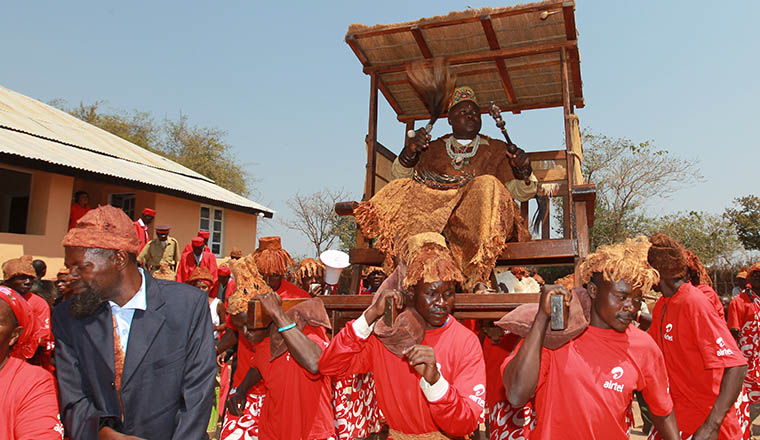
VISITS TO KABWE KATENDA AND NG’ANSA SALT PAN
Builile Traditional ceremony is an annual event of the Bwile speaking People of Senior Chief Puta of Chiengi District, Luapula Province. The ceremony is held in celebrating the identity and behavioral traits of the Bwile people such as self-reliance, freedom, liberty and strategic leadership in times of adversity.
Senior Chief Puta, while being carried on a hammock, leds scores of people to kabwe katenda to pay homage to the ancestral spirits. Kabwe katenda is a holy shrine of the Bwile speaking people situated on top of hills. His Royal Highness Senior Chief Puta is escorted by Bwile Sub Chiefs, Village Head Persons, and other traditional leaders while being guided by the Bwile spiritualists to pay homage to the ancestral spirits. Whilst there, cultural dances and activities are performed by cultural groups.
. According to the Bwile folklore, the ng’ansa salt pan was established as a Bwile economic enterprise which enabled the Bwile people to engage in trade with neighboring tribes. As such, they pride themselves as probably the only tribe in Zambia who never shed blood to secure their land.
CELEBRATION OF FISHING HERITAGE
Characterized b carrying of Senior Chief Puta on a hammock from the palace, accompanied by the Bwile Sub-Chiefs and scores of people, to Nambele beachfront for festive activities which included traditional dances and roasting of fish. Thereafter, a presentation of roasted fish is made to Senior Chief Puta who also shares the roasted fish with the invited guests. Whilst at the beachfront, various entertainments which included traditional dances are performed to the amusement of the people.
CHABUKA TRADITIONAL CEREMONY
The ceremony was held on the banks of Luapula River in Matanda Chiefdom of Mansa District. It is an annual event which is held in remembrance of the crossing of the Luapula River from Kola in present day Democratic Republic of Congo to Zambia by seven tribal groups. Among the groups were the Bemba people of Northern Province and the Lunda people of Mwata Kazembe.
The climax of the ceremony is when a group of people demonstrates on how the crossing of the Luapula River from Ituri forest in the Democratic Republic of Congo to Matanda Chiefdom in Zambia was done.
Chabuka Traditional Ceremony is a very rich and important ceremony which should be upheld. The celebration was graced with a lot of meaningful dances and presentations which not only entertained the people gathered at the arena but also educated them
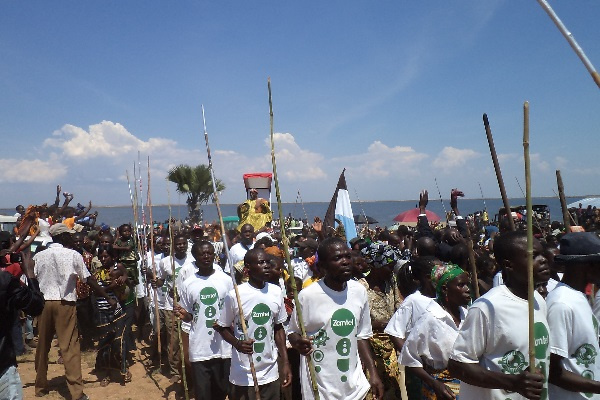
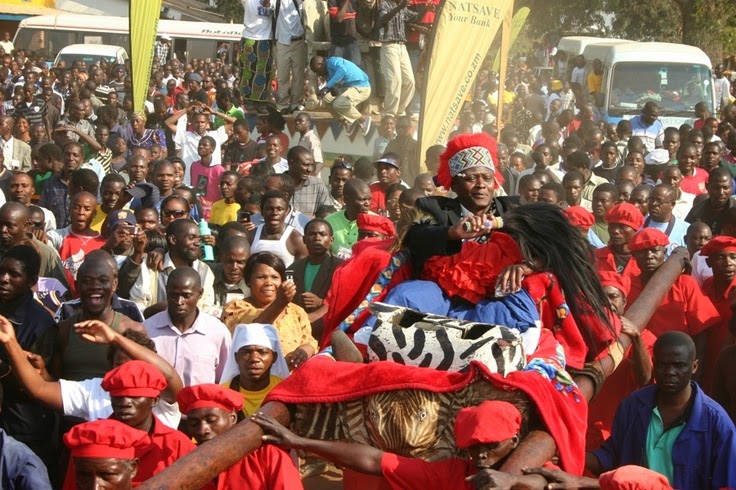
MUTOMBOKO CEREMONY
Mutomboko ceremony is the traditional ceremony which is held annually in mwansabombwe District, mwata kazembes headquarters on the last Saturday of July.
Umutomboko means a dance victory or dance of conquest. The origin and importance of umutomboko ceremony is linked with the 17th century when the Lunda crossed the Luapula River into Zambia, fighting their way through and in the process conquering weaker and smaller tribes. The Lunda crossed the Luapula River into Zambia near chief matandas village of mansa district. During inter-tribal wars, the Lunda won many battles and naturally, that called for great joy and excitement .Dances of victory were performed and songs of jubilation were sung. The umutomboko formed the climax of the day when the chief dressed in traditional regalia danced to the beating of traditional drums.
Aside from symbolizing conquest, umutomboko is sometimes also viewed as Mwata’s harvest period for it is during this time that he receives ‘Title’ from his subjects. It is also the time of reckoning for erring chiefs and village headmen who appear before Mwata for displinary action. The ceremony highlights not only the Lunda people’s war endeavors, but also exhibits the rich cultural heritage and traditions of the Lunda kingdom
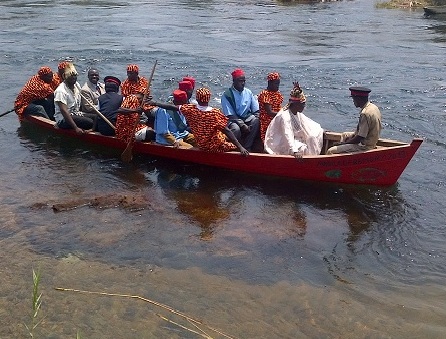
MABILA TRADITIONAL CEREMONY
Mabila Traditional Ceremony of His Royal Highness Senior Chief Mununga XIV, Chula I, Mutampuka II, of the Shila People of Mununga, Chienge, and the traditional ceremony is basically the depicting of the Shila People’s fishing techniques, methods and practices.
The Muchelenge Rock named after the first Chief Mununga is a holy shrine of the Shila People, believed to have been used as a hiding place by the first Chief Mununga (Muchelenge) during the time of war with the Lunda of Mwata Kazembe until the Shila People defended their land
Chimbila Ancestral Site
During the cerebration, His Royal Highness Senior Chief Mununga XIV, Chula I, Mutampuka II, leads scores of people, together with, sub chiefs and village head persons to Chimbila Ancestral Site to pay homage and sacrifices to the gods and ancestral spirits, as the ancestral site was viewed as a small falls for old Chiefs that they used for trapping fish using a basket form called Umusaso.
At the same ancestral site, display of how Shila People used to catch fish and methods used are displayed
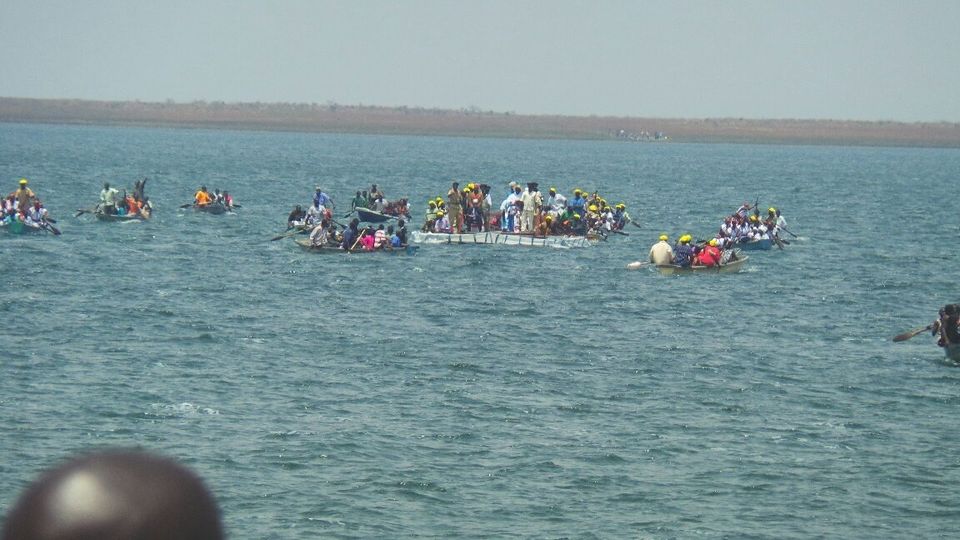
KWANGA CEREMONY
The kwanga traditional ceremony is celebrated by five chiefs of benaNgu’mbo clan together with the mwansakombe.its take place at the arena on the shores of the lake chifunabuli in chief chitembo’s in lubwe on the first Saturday of October. It is cerebrated as a symbol of unity among the chief and his people who joined solidarity and remember their origin.
The kwanga ceremony is a cerebration of victory in songs and dances, cerebrating the victory of benang’umbo over the tribes they have vanquished on their way to occupy their land. The kwanga ceremony also cerebrates recent event, the overcoming of evil brotherhood and collaboration. It cerebrate the victory of benangunbo over kabaya, a cannibal who had settled in the area around masanta. This man terrorized the benaNgumbo by ambushing their woman and taking away their children and their babies whom he killed, cooked and eat. All attempt to Conner and capture kabaya failed. The benangumbo stared in fear and failed to go out in their field or to fish in the lake; famine was imminent. Some brave clever benangumbo men finally approached kabaya and lured him from his home enticing him to come to the cerebration of his life on Lake Kamimbi. They took many boats with lots of men as well as women sing song of praise for kabaya and offered him the largest boat to ride and a number of strong man to row him. What kabaya did not know was that the men had drilled holes in the bottom of the boat and temporarily plugged them. When they got to the middle of the lake the men in kabaya’s boat unplugged the hole and jumped out, leaving kabaya who could not swim in the boat. Though kabaya drowned, the men all swan into nearby boats and paddled back to the village where everyone joined in song and dance. From that day the lake was renamed from kamimbi to chifunabuli, meaning “that which has fixed the enemy.”
The two to three day kwanga ceremony is also a thanks giving ceremony. On the first day the chiefs gather to involve their ancestral spirits at various shrines at masanta and imange to give thanks and asking for blessing. They begins by visiting the muchimbili tree which is the largest tree inside which kabaya was believed to hide whenever warriors attempt to kill him. A close examination of the tree shows many arrow heads still embedded in its truck while other have been completely covered within truck. On the second the ceremony continues with the colourful journey by the chief and their people in boats from kasanta to chifunabuli to the arena at lubwe. All five chiefs ride in one boat surrounded by hundreds of boat filled with their warriors and subjects who display fearless and artistic maneuvers on the lake while they sing and dance. The arena is the hive of activities characterized by songs and dance, including the favorite kalela dance of benangu’mbo and oratory. The ceremony ends with the performance of a victory dance by the senior chief and the warrior.
